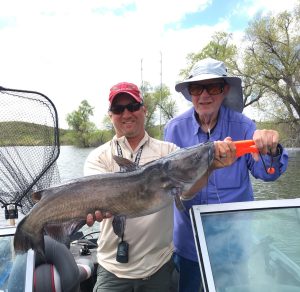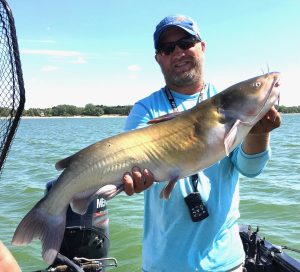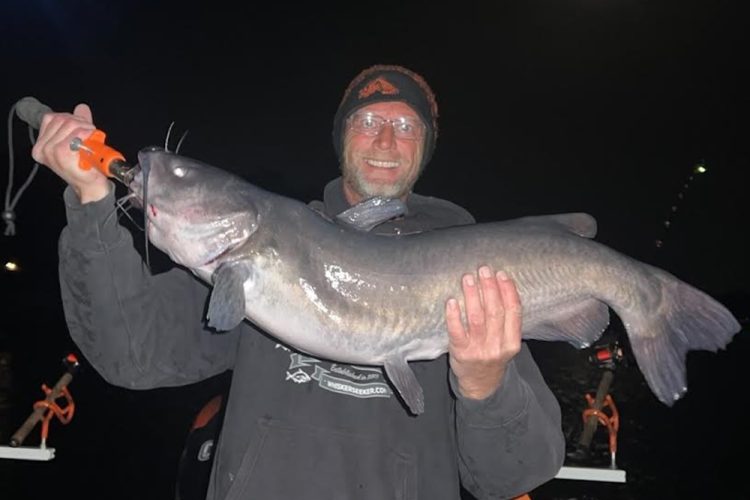Jimmi Brown, a guide in central Iowa, holds proof that the Hawkeye State contains some trophy channel catfish.
Farm Country Cats
Story and Photos By Brent Frazee
Big channel catfish thrive in the lakes of Nebraska, Iowa and Kansas.
Looking for a big, corn-fed channel cat? Head to farm country. Nebraska, Kansas, South Dakota and Iowa are better known for their pheasants and deer, but some huge whiskered fish cruise under the radar.
Yeah, we know. It doesn’t sound too impressive when you say you’re going to the boonies of ag country for your next vacation. But if you’re a die-hard channel cat angler, that’s definitely something you should check out.
Nebraska
“The walleye is king here in Nebraska,” said Daryl Bauer, fisheries outreach program manager for the Nebraska Game and Parks Commission. “But we have some great channel-cat fishing that sometimes gets overlooked.”
No one knows that better than Tyler Brown who runs the Tooth and Whisker Guide Service on Merritt Reservoir in the Sandhills of north-central Nebraska. When he started guiding 10 years ago, walleyes were the target species. When the toothy gamefish weren’t biting, he would switch gears and pursue the reservoir’s big channel cats.

The catfish saved many a guide trip for Brown. As he gained a reputation for putting anglers on Master Angler fish (30 inches or longer), they started coming back specifically for channel cats.
Brown himself has landed a fish as big as 25 pounds. And he is convinced other big ones still roam the scenic, remote reservoir.
“Merritt is full of Master Angler channel cats,” said Brown, whose also runs Tooth and Whisker Outdoors, a bait and tackle shop in Valentine, Nebraska. “The size of the fish has gone down somewhat over the years, but there are still big numbers of 12- to 15-pound fish.”
Bauer agrees, pointing out that Merritt remains one of the best big-channel cat reservoirs in Nebraska. But there are others. Calamus Reservoir (5,200 acres, also in the Sandhills region) is known for its hefty channel cats, too. Box Butte Reservoir (1,600 acres in the northwest part of the state) is another that offers good chances for 12- to 20-pound channels
Brown starts by targeting shallow weedbeds in the spring, often fishing with cut-bait under a bobber. In his experience, the channel cats will stay shallow until July, then they move out to deeper water.
In the summer, Brown likes to drift with cut-bait over drop-offs, points and flats. Wind plays an important part. Brown tries to present his baits at 0.5 miles per hour. On windy days, he will put out wind socks to slow his presentation. If there is little wind, he will use his trolling motor and Parks planer boards to cover water.
Iowa
Jimmi Brown (no relation to Tyler) grew up tagging along with his grandparents when they fished for channel catfish, bullheads and carp. When he discovered how abundant big channel catfish were in central Iowa, he was hooked.
Today, he runs the Chasin’ Cats Guide Service, which he describes as catering to a niche market. He guides primarily on Saylorville and Red Rock reservoirs in central Iowa, which both have excellent channel-cat populations.

“Your chances of catching a Master Angler (30 inches or bigger) are better at Saylorville,” Brown said. “But Red Rock has a big population of channel cats, too.”
Brown gets off to an early start when fishing for channel catfish, getting on the water as soon as the ice goes off. He will target shallow water where the wind is blowing in. That’s where the big channel cat will often be gorging on winter-killed baitfish.
He will use a slip bobber and everything from dead shad to live creek chubs for bait.
As the water warms, he likes to drift when there is a moderate wind or pull baits with planer boards when it is calm.
“I want to cover as much water as possible to find the feeding catfish,” he said.
Sometimes, the fish are surprisingly shallow. “There are times when they’re so shallow you can see their fins sticking out of the water,” he said.
The warmer the water temperature, the faster he will troll with the cut-bait he offers, Brown said.
Size of the bait also plays a part. In the spring, he uses small pieces. He will go to larger pieces in the summer, and even bigger pieces in the fall.
Kansas
It’s little wonder that the channel catfish is the state fish in Kansas. The Sunflower State is loaded with the whiskered fish, and the Kansas Department of Wildlife and Parks has long claimed that the fish are underutilized.
Anglers who know what they are doing catch some giants out of reservoirs such as John Redmond, Perry, Glen Elder, Toronto and Fall River.
Some of the biggest fish of the year come in fall when the cormorants migrate in and perch on flooded timber in reservoirs such as John Redmond and Glen Elder. When the birds defecate, it results in natural stinkbait from the shad they have consumed.
Fishermen will stay withing casting distance of the trees the birds use as roost trees and will use fresh cut shad. The result? Fish exceeding the 20-pound mark are caught each fall.
So, when you’re sitting inside this winter, planning your 2025 fishing trips, don’t overlook the nation’s breadbasket. The channel cat of a lifetime might await.
(Brent Frazee has been writing about the outdoors for almost 50 years. He was the outdoors editor for The Kansas City Star for 36 years before retiring in 2016. He continues to freelance for magazines, websites, newspapers and tourism agencies. He lives with his wife Jana and two yellow labs, Millie and Maggie, on a private lake in a suburb of Kansas City, Missouri.)



